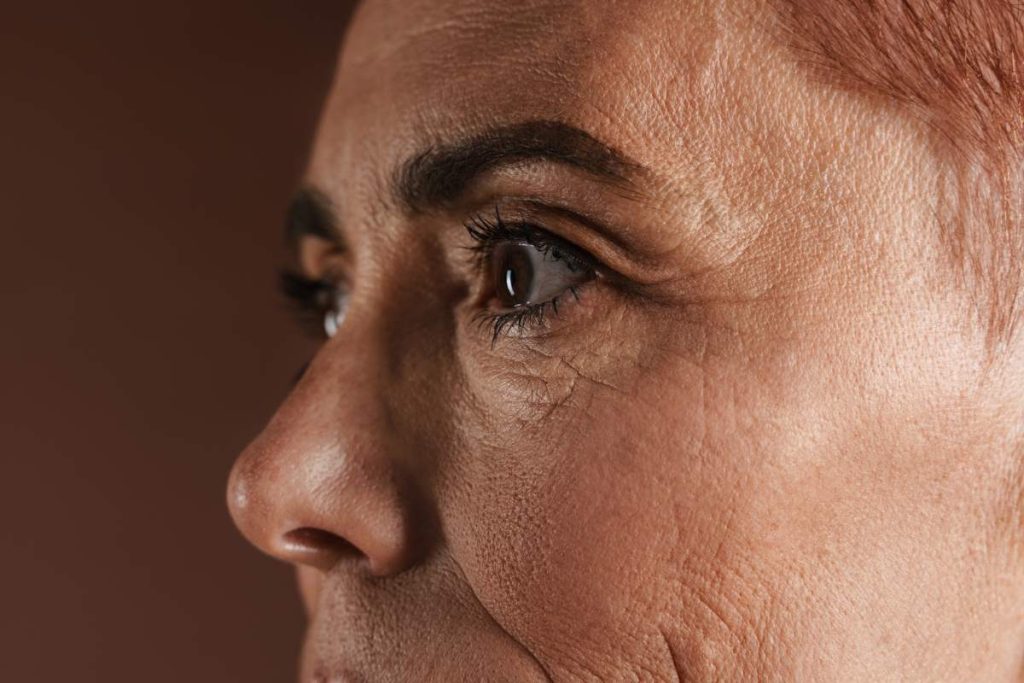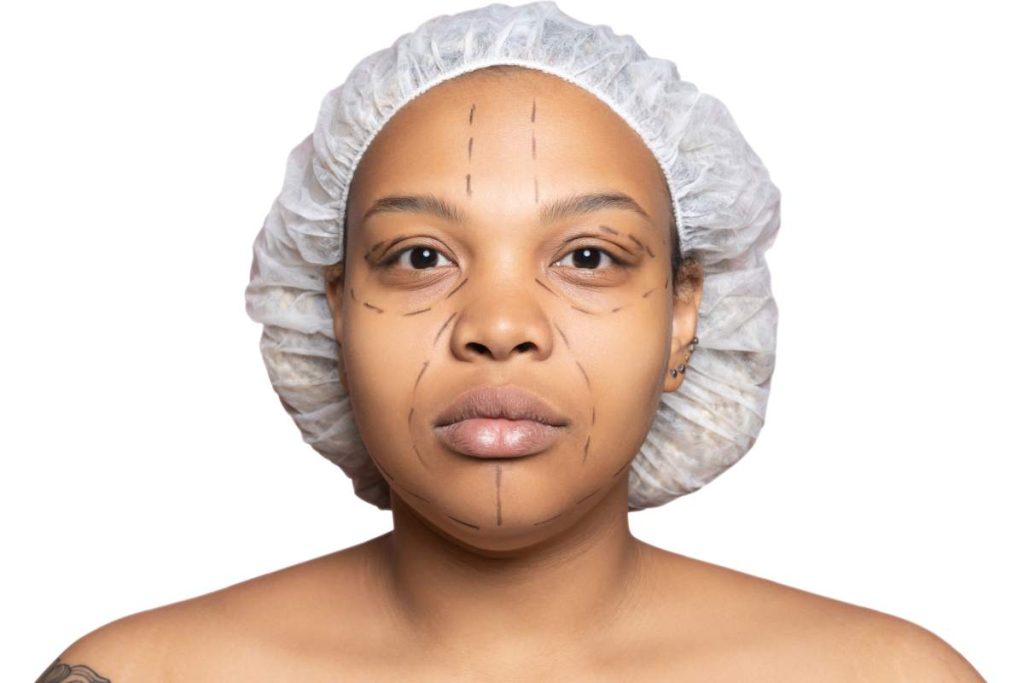Sagging skin isn’t harmful, but it can affect how someone feels about their appearance. It often happens as people get older or after significant weight loss. Some rare medical conditions can also cause loose skin.
Certain lifestyle choices can make skin sagging happen sooner. For example, a poor diet and too much sun exposure can contribute to early skin ageing and sagging.
This article explains why skin sags and offers tips on how to prevent it. It also includes methods that might help improve the look of sagging skin.
What is a Sagging Face?
A sagging face refers to the appearance of drooping or loose skin, often seen in the lower parts of the face, such as the cheeks, jawline, and neck. This condition is commonly associated with ageing, but various factors can contribute to it.
Appearance of a Sagging Face
A sagging face typically features:
- Drooping Cheeks: The cheeks may appear lower and less defined, with a noticeable loss of volume.
- Sagging Jawline: The jawline may lose its definition, leading to a less sharp or more rounded appearance.
- Loose Neck Skin: The skin around the neck can become loose and may develop a “double chin” appearance.
- Deepening Nasolabial Folds: The lines running from the sides of the nose to the corners of the mouth can become more pronounced.

What Causes a Sagging Face?
A sagging face is a common concern as people age, and it can be caused by a variety of factors.
Here are the common causes of a sagging face:
1. Loss of Collagen and Elastin
As we age, our skin undergoes significant changes. Collagen and elastin are proteins in the skin that provide structure, firmness, and elasticity. Collagen acts like a scaffold, supporting the skin, while elastin allows it to stretch and bounce back.
Over time, the production of these proteins decreases, and existing ones break down, leading to a loss of firmness and elasticity. This reduction in collagen and elastin makes the skin more prone to sagging.
2. Gravity
Gravity plays a significant role in the sagging of facial skin. Over the years, the constant pull of gravity causes the skin and underlying tissues to slowly droop. This effect is more noticeable in areas like the cheeks, jawline, and neck. While gravity affects everyone, its impact becomes more visible as the skin’s support structures weaken with age.
3. Fat Loss
Facial fat provides padding and support to the skin. As people age, there is a natural loss of fat in the face, especially in the cheeks and under the eyes. This fat loss can result in a hollowed appearance and contribute to sagging. The reduction in fat can also affect the overall volume of the face, making it look more sunken and less youthful.
4. Sun Damage
Exposure to the sun’s ultraviolet (UV) rays can accelerate skin ageing. UV radiation damages the skin’s collagen and elastin fibres, leading to premature ageing and sagging. Sun damage also causes the skin to lose moisture and elasticity, which further contributes to the sagging appearance.
5. Lifestyle Factors
Certain lifestyle habits can exacerbate facial sagging. Smoking, for example, reduces blood flow to the skin and damages collagen, leading to premature ageing. Poor diet, lack of exercise and lots of cheat days, and insufficient hydration can also negatively impact skin health, making it more prone to sagging.
6. Genetics
Genetics play a significant role in how our skin ages. Some people are genetically predisposed to develop sagging skin earlier than others. If your parents or grandparents experienced noticeable sagging, you might be more likely to experience it as well.
7. Facial Expressions
Repeated facial movements and expressions can contribute to sagging over time. Expressions like frowning, smiling, and squinting can create lines and wrinkles. While these expressions are a normal part of life, they can contribute to the formation of deeper wrinkles and sagging skin.

Is It Possible to Reverse Face Sagging?
Reversing facial sagging is a common concern, especially as we age and notice changes in our skin. While complete reversal may not always be possible, some several effective methods and treatments can help improve the appearance of sagging skin and restore a more youthful look.
1. Skincare Products
Using the right skincare products can make a noticeable difference in the appearance of sagging skin. Look for products that contain ingredients known to support skin firmness and elasticity:
- Retinoids: These are derived from vitamin A and help boost collagen production, which can improve skin texture and reduce sagging.
- Hyaluronic Acid: This ingredient helps retain moisture in the skin, making it appear plumper and firmer.
- Vitamin C: Known for its antioxidant properties, vitamin C helps with collagen synthesis and can brighten the skin.
Regular use of these products can help improve skin tone and texture over time.
2. Facial Exercises
Facial exercises, sometimes referred to as facial yoga, involve specific movements and stretches designed to strengthen the facial muscles. These exercises can help lift and tone the skin, potentially reducing the appearance of sagging. Common exercises include:
- Cheek lifts: Smile widely while placing your fingers on your cheeks, then lift your cheeks upwards.
- Jawline exercises: Tilt your head back and look at the ceiling, then move your lower jaw forward.
While not a miracle solution, consistent practice may contribute to a firmer appearance.
3. Healthy Lifestyle
Maintaining a healthy lifestyle can have a significant impact on your skin’s appearance:
- Diet: Eating a balanced diet rich in fruits, vegetables, lean proteins, and healthy fats supports skin health. Foods high in antioxidants, like berries and green leafy vegetables, help protect the skin from damage.
- Hydration: Drinking plenty of water keeps your skin hydrated and can help maintain its elasticity.
- Avoiding Smoking: Smoking damages collagen and elastin, contributing to premature ageing. Quitting smoking can improve your skin’s overall health and appearance.
4. Professional Treatments
For more significant results, professional treatments can be effective in reducing sagging and improving skin appearance:
- Dermal Fillers: These are injectable treatments that add volume to areas of the face that have lost fat, such as the cheeks and under the eyes. They help restore a youthful contour and reduce sagging.
- Botox: Botox injections can relax the muscles responsible for creating wrinkles and fine lines, which can indirectly reduce the appearance of sagging.
- Laser Therapy: Laser treatments stimulate collagen production and tighten the skin. They can help improve skin texture and firmness.
- Ultrasound Therapy: Techniques like Ultherapy use ultrasound energy to stimulate deeper layers of the skin, promoting collagen production and lifting sagging areas.
5. Surgical Options
For those seeking more dramatic results, surgical options are available:
- Facelift Surgery: A facelift involves removing excess skin and tightening the underlying tissues to create a more youthful appearance. It is a more invasive option but can provide significant and long-lasting results.
- Neck Lift: This procedure focuses on tightening the skin and underlying muscles in the neck area, which can improve the overall appearance of sagging in the lower face.
Final Thoughts
While it may not be possible to completely reverse facial sagging, there are many effective ways to improve the appearance of sagging skin. From skincare and lifestyle changes to professional treatments and surgical options, you have various tools at your disposal to help achieve a more youthful look.
Consulting with a dermatologist or cosmetic professional can help you determine the best approach based on your individual needs and goals.
If you want a trusted cosmetic professional in Thailand, Kamol Hospital might be your number 1 answer. As one of the worlds leading cosmetic surgery hospitals, their standard is second to none, so you can rest your trust and gain your self-esteem back again!









